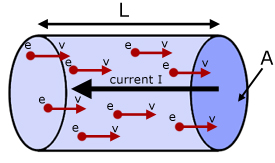Home >> Electricity, concepts & units 2
resistivity |
Resistivity ρ (rho)
By experiment it has been found that the resistance R of a material is directly proportional to its length l and inversely proportional to its cross-sectional area A.
![]()
Making the proportionality an equation, the constant of proportionality ρ (rho) is called the resisitivity.
![]()
Rearranging the equation and making the length and area unity, we can form a definition for the quantity.

The resistivity of a material is the resistance of a cube of side 1 m, across opposite faces.
The units of resistivity can be found by substituting the units for l , A and R in the resistivity equation.

Resistivity is measured in units of ohm-metres(Ω.m) .
Typical values of resistivity are:
|
metals ~10-8 |
Conductance G
By definition, the conductance of a material is the reciprocal of its resistance. The unit of conductance is the Seimens S.
![]()
Conductivity σ (sigma)
By definition, the conductivity of a material is the reciprocal of its resistivity. The units of conductivity are Sm-1 or Ω-1m-1 .

Current density J
Current density at a point along a conductor, is defined as the current per unit cross-sectional area.
![]()
The units of current density J are amps per m2 or Am-2 .
Conduction in metals
Metal atoms in crystal lattices each tend to lose one of their outer electrons. These free electrons wander randomly inside the crystal.
If a p.d. is applied across the metal, electrons drift in the direction of the positive contact. Since electrostatic field direction is from positive to negative, the direction is against the field.
The drift velocity, as it is called, is of the order of 10-3 ms-1 . When the electrons move through the crystal lattice they collide with metal ions. Each collision imparts kinetic energy from an electron to an ion. The ions thus gain vibrational energy and as a consequence the temperature rises. This phenomenon is called ohmic heating.
The potential difference produces a steady current through the metal. On their journey electrons gain and lose KE. The total amount of energy involved per m3 is a measure of the resistivity of the particular metal.
Expressions for the current I through a conductor and the current density J can be formed using the concept of drift velocity v .

where:
|
I - current flowing through conductor |
From the diagram the following can be implied:
|
volume of the cylindrical section = LA
no. free electrons in the section = nLA
quantity of mobile charge Q in the section = nLAe
|
The time t for all the electrons in the section to travel from one face to the another is the time for one electron (on the far right) to travel the whole length.
![]()
since,
![]()
substituting for Q and t,

since current density J is defined as:
![]()
it follows that,

[ About ] [ FAQ ] [ Links ] [ Terms & Conditions ] [ Privacy ] [ Site Map ] [ Contact ]
